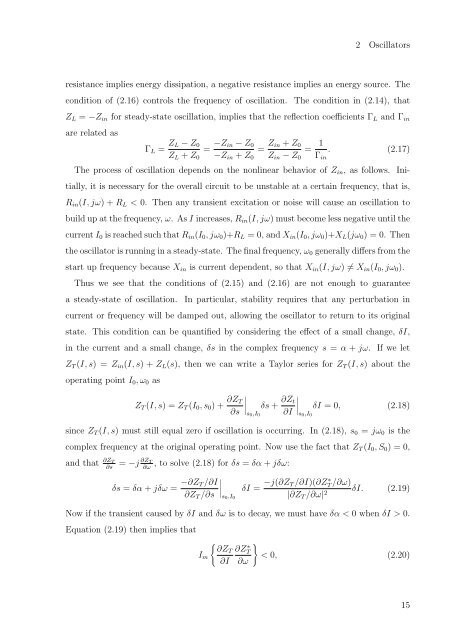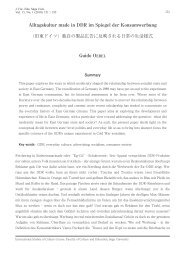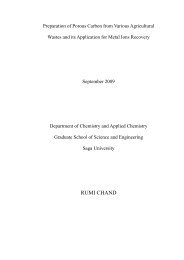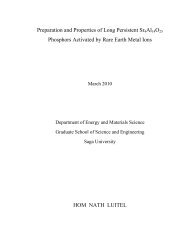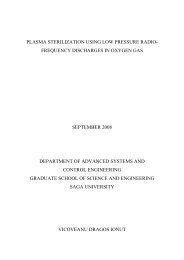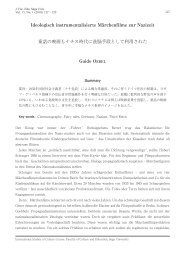High Order Harmonic Oscillators in Microwave and Millimeter-wave ...
High Order Harmonic Oscillators in Microwave and Millimeter-wave ...
High Order Harmonic Oscillators in Microwave and Millimeter-wave ...
- No tags were found...
Create successful ePaper yourself
Turn your PDF publications into a flip-book with our unique Google optimized e-Paper software.
2 <strong>Oscillators</strong><br />
resistance implies energy dissipation, a negative resistance implies an energy source. The<br />
condition of (2.16) controls the frequency of oscillation. The condition <strong>in</strong> (2.14), that<br />
Z L = −Z <strong>in</strong> for steady-state oscillation, implies that the reflection coefficients Γ L <strong>and</strong> Γ <strong>in</strong><br />
are related as<br />
Γ L = Z L − Z 0<br />
Z L + Z 0<br />
= −Z <strong>in</strong> − Z 0<br />
−Z <strong>in</strong> + Z 0<br />
= Z <strong>in</strong> + Z 0<br />
Z <strong>in</strong> − Z 0<br />
= 1<br />
Γ <strong>in</strong><br />
. (2.17)<br />
The process of oscillation depends on the nonl<strong>in</strong>ear behavior of Z <strong>in</strong> , as follows. Initially,<br />
it is necessary for the overall circuit to be unstable at a certa<strong>in</strong> frequency, that is,<br />
R <strong>in</strong> (I,jω) + R L < 0. Then any transient excitation or noise will cause an oscillation to<br />
build up at the frequency, ω. As I <strong>in</strong>creases, R <strong>in</strong> (I,jω) must become less negative until the<br />
current I 0 is reached such that R <strong>in</strong> (I 0 ,jω 0 )+R L = 0, <strong>and</strong> X <strong>in</strong> (I 0 ,jω 0 )+X L (jω 0 ) = 0. Then<br />
the oscillator is runn<strong>in</strong>g <strong>in</strong> a steady-state. The f<strong>in</strong>al frequency, ω 0 generally differs from the<br />
start up frequency because X <strong>in</strong> is current dependent, so that X <strong>in</strong> (I,jω) ≠ X <strong>in</strong> (I 0 ,jω 0 ).<br />
Thus we see that the conditions of (2.15) <strong>and</strong> (2.16) are not enough to guarantee<br />
a steady-state of oscillation. In particular, stability requires that any perturbation <strong>in</strong><br />
current or frequency will be damped out, allow<strong>in</strong>g the oscillator to return to its orig<strong>in</strong>al<br />
state. This condition can be quantified by consider<strong>in</strong>g the effect of a small change, δI,<br />
<strong>in</strong> the current <strong>and</strong> a small change, δs <strong>in</strong> the complex frequency s = α + jω. If we let<br />
Z T (I,s) = Z <strong>in</strong> (I,s) + Z L (s), then we can write a Taylor series for Z T (I,s) about the<br />
operat<strong>in</strong>g po<strong>in</strong>t I 0 ,ω 0 as<br />
Z T (I,s) = Z T (I 0 ,s 0 ) + ∂Z T<br />
∂s<br />
∣ δs + ∂Z t<br />
∣ δI = 0, (2.18)<br />
s0 ,I 0 ∂I s0 ,I 0<br />
s<strong>in</strong>ce Z T (I,s) must still equal zero if oscillation is occurr<strong>in</strong>g. In (2.18), s 0 = jω 0 is the<br />
complex frequency at the orig<strong>in</strong>al operat<strong>in</strong>g po<strong>in</strong>t. Now use the fact that Z T (I 0 ,S 0 ) = 0,<br />
<strong>and</strong> that ∂Z T<br />
∂s<br />
= −j ∂Z T<br />
, to solve (2.18) for δs = δα + jδω:<br />
∂ω<br />
δs = δα + jδω = −∂Z T/∂I<br />
∂Z T /∂s<br />
∣<br />
s0 ,I 0<br />
δI = −j(∂Z T/∂I)(∂Z ∗ T/∂ω)<br />
|∂Z T /∂ω| 2 δI. (2.19)<br />
Now if the transient caused by δI <strong>and</strong> δω is to decay, we must have δα < 0 when δI > 0.<br />
Equation (2.19) then implies that<br />
I m<br />
{ ∂ZT<br />
∂I<br />
∂Z ∗ T<br />
∂ω<br />
}<br />
< 0, (2.20)<br />
15


